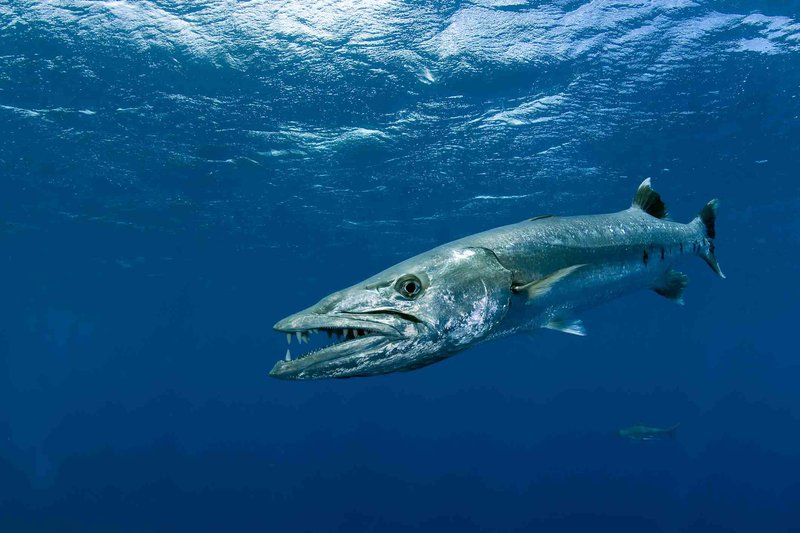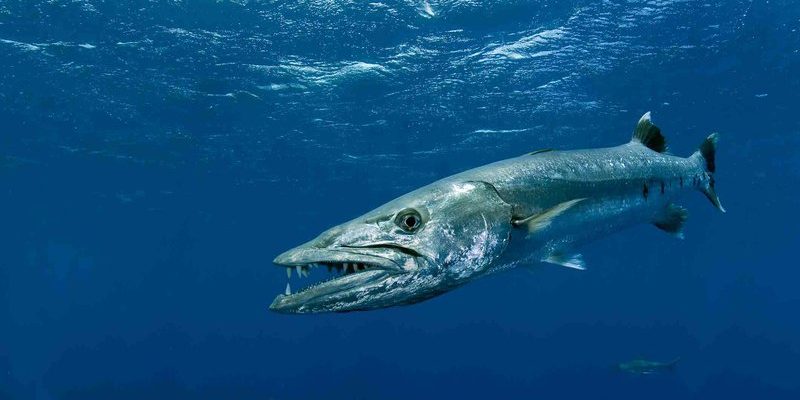
Imagine a sleek, silver torpedo slicing through the ocean waters. That’s the barracuda for you—a true marvel of nature. Known for their elongated bodies and fierce predatory skills, these fish have both fascinated and terrified many. With sharp teeth and a powerful build, barracudas are the epitome of what it means to be a hunter in the underwater world. But there’s so much more to learn about them beyond their ferocious reputation.
Barracudas belong to the family Sphyraenidae and are found in warm, tropical oceans around the globe. They are often spotted lurking in reefs, where they ambush unsuspecting prey. While they may have a fearsome appearance, barracudas play a critical role in maintaining the balance of their marine ecosystems. So, let’s dive deeper into the world of barracudas and explore their fascinating biology, behavior, and ecology.
Physical Characteristics of Barracuda
Barracudas vary in size, but most species grow to impressive lengths. The average barracuda measures around 3 to 5 feet, though some individuals can reach lengths of up to 6 feet or more! Their streamlined bodies are perfect for swift movement through the water, with muscular tails that provide powerful propulsion. Their skin typically shines in hues of blue or green with silvery underbellies, helping them blend seamlessly into the ocean depths.
Another notable feature of barracudas is their mouth, filled with sharp, triangular teeth. These teeth are designed for grabbing and holding onto slippery prey. Combined with their keen eyesight, barracudas are incredible hunters. They can spot a potential meal from quite a distance, thanks to their excellent vision in low light conditions. This helps them be effective both at dawn and dusk when they are most active.
Let’s take a quick look at some essential facts about barracudas:
| Average Size: | 3–5 feet |
| Maximum Size: | Up to 6 feet |
| Weight: | 10–60 pounds |
| Habitat: | Tropical and subtropical oceans |
| Diet: | Fish, squid, crustaceans |
| Speed: | Up to 36 mph |
| Lifespan: | 10–14 years |
Habitat and Distribution
Barracudas thrive in warm, shallow waters, particularly in tropical and subtropical regions. You can find them near coral reefs, seagrass beds, and rocky outcrops, which provide excellent spots for hunting. These environments are not just home; they also serve as hunting grounds where barracudas can lie in wait for fish and other prey. Their preferred habitats are often abundant with smaller fish, which makes it easier for them to find food.
Across the globe, you’ll find different species of barracudas, with the Great Barracuda being the most well-known. This species is primarily located throughout the Caribbean Sea, Gulf of Mexico, and on the Atlantic coast of the Americas. They are not shy and can often be seen swimming close to the surface, making them a favorite among divers and snorkelers. Just remember that while they may look fascinating, it’s wise to respect their space and keep a safe distance.
What’s intriguing is that barracudas can often be seen schooling. These groups can range in size and are typically composed of individuals that are similar in size. This schooling behavior is essential for both hunting and avoiding larger predators. It’s almost like a tactical team at play, where they work together to outsmart their prey. They can easily turn sharp and fast, often catching their meals by surprise. Isn’t nature just amazing?
Diet and Hunting Behavior
Barracudas are carnivorous and primarily feed on smaller fish, squid, and occasionally crustaceans. Their sharp teeth and powerful jaws are designed for tearing through the flesh of their prey. When it comes to hunting, barracudas exhibit remarkable speed and agility. They can dart in and out of their habitats, surprising fish that might otherwise think they are safe.
Here’s the thing: barracudas are ambush hunters. They often stake out in strategic locations, lurking in the shadows of corals or seagrass. When they spot a potential meal, they launch a rapid attack. Their ability to swim at speeds up to 36 mph is an advantage in these high-stakes moments, allowing them to catch prey off guard. It’s a thrilling game of cat and mouse in the blue sea!
During their hunting expeditions, barracudas often employ a tactic known as “hit and run.” They strike quickly, aiming for the sides of their prey before they can react. This method ensures they minimize their own risk while maximizing their chances of a successful catch. Their keen eyesight is another crucial factor; they can even see in murky water, which helps them to track and pursue fish effectively. Watching a barracuda hunt is like witnessing a well-choreographed dance, full of grace and precision.
Reproductive Habits
When it comes to reproduction, barracudas have some fascinating behaviors. They are known to spawn in offshore waters, usually during warmer months. During this breeding period, male barracudas often engage in flashy displays to attract females. These displays can include rapid swimming and circling around potential mates, showcasing their strength and vitality.
Typically, barracudas are not monogamous and may mate with multiple partners during a spawning season. The females release thousands of eggs, which float to the surface and are left to develop on their own. This strategy is a bit of a “survival of the fittest” approach, as many eggs won’t survive to hatch due to predation or environmental factors. However, those that do hatch grow quickly, as barracuda fry are born with instincts that help them evade predators right from the start.
Interestingly, barracuda populations can be affected by various environmental factors, including water temperature and habitat availability. Humans impact these populations too, often through fishing or habitat destruction. This makes understanding their reproductive habits vital for conservation efforts. Protecting the environments where barracudas breed and spawn is crucial for maintaining healthy populations in our oceans.
Conservation Status
The conservation status of barracudas varies across different regions and species. Some populations are thriving, while others face pressures from overfishing and habitat degradation. Barracuda flesh is highly prized in some culinary circles, leading to intense fishing in certain areas. This has raised concerns about sustainability and the long-term effects on their population.
Organizations and researchers are working hard to monitor barracuda populations and implement sustainable fishing practices. Regulations may include size limits, seasonal closures, and protected areas to help ensure that barracuda populations remain stable. These measures are essential because barracudas play a vital role in the marine ecosystem. By controlling the populations of smaller fish, they help maintain the balance in their environments.
Another challenge for these remarkable fish is climate change. Rising sea temperatures and ocean acidification can significantly impact the ecosystems that barracudas depend on. This can further reduce their prey availability and affect their breeding habitats. It’s crucial for us to engage in conversations about marine conservation and to support efforts that aim to protect these outstanding predators and their habitats.
FAQ
What do barracudas eat?
Barracudas are primarily carnivorous, feeding on smaller fish, squid, and crustaceans. They are skilled hunters and use their speed and sharp teeth to capture their prey efficiently. A single barracuda can consume a variety of fish species, including mackerel and mullet, making them formidable predators in their ecosystems.
Are barracudas dangerous to humans?
While barracudas can be intimidating due to their sharp teeth and fierce appearance, they are generally not dangerous to humans unless provoked. Most barracuda attacks on humans are a result of mistaken identity when they are attracted to shiny objects, such as jewelry. It’s important to respect their space and avoid feeding them in the wild.
How fast can barracudas swim?
Barracudas are incredibly fast swimmers, capable of reaching speeds up to 36 miles per hour. This speed is essential for their hunting strategies, allowing them to quickly close the distance on their prey and execute swift attacks. Their streamlined bodies and powerful tails are tailored for speed and agility in the water.
Where can I find barracudas?
Barracudas are typically found in warm, tropical, and subtropical oceans. They inhabit coastal areas, coral reefs, and rocky structures, where they can find ample prey. Popular locations to spot barracudas include the Caribbean Sea, Gulf of Mexico, and various locations along the Atlantic coast.
What are the different species of barracuda?
There are several species of barracuda, but the most well-known is the Great Barracuda (Sphyraena barracuda). Other species include the Cuban Barracuda, Blackfin Barracuda, and the Narrow-barred Barracuda. Each species has its own unique traits and habitat preferences, but they all share similar predatory behaviors.
What is the lifespan of a barracuda?
The lifespan of a barracuda typically ranges from 10 to 14 years, depending on the species and environmental conditions. Factors such as fishing pressure, habitat quality, and food availability can influence their longevity. Protecting their habitats and reducing overfishing practices are critical for sustaining healthy barracuda populations.
Do barracudas have any natural predators?
While adult barracudas are top predators in their environments, they are not without threats. Larger marine creatures, such as sharks and larger fish species, may prey on juvenile barracudas. Additionally, humans pose a significant threat through fishing and habitat destruction, affecting barracuda populations.
How do barracudas reproduce?
Barracudas reproduce by spawning in offshore waters, typically during warmer months. Females release thousands of eggs that float to the surface, where they develop independently. This reproductive strategy allows for population growth, but it also means that many eggs will not survive due to predation and environmental conditions.
What role do barracudas play in their ecosystem?
Barracudas play a vital role in maintaining the balance of marine ecosystems. As apex predators, they help control the populations of smaller fish, which can prevent overpopulation and ensure a healthy diversity of species. Their hunting behaviors contribute to the overall health of coral reefs and other marine habitats.
Are barracudas social animals?
Barracudas exhibit both solitary and social behaviors. While they can often be seen alone, they also form schools, especially when hunting. These schools consist of barracudas of similar sizes, allowing them to work together to catch prey and evade larger predators. Their social dynamics can be quite fascinating to observe!
Can barracudas be kept in aquariums?
Keeping barracudas in aquariums is challenging due to their size, dietary needs, and territorial behavior. Commercial aquariums can accommodate them, but they require large tanks with plenty of swimming space and appropriate water conditions. For hobbyists, it’s essential to do thorough research before attempting to keep barracudas as pets.
How do barracudas adapt to their environment?
Barracudas are well-adapted to their marine environments. Their streamlined bodies and powerful tails allow them to swim swiftly and efficiently. Additionally, their keen eyesight helps them spot prey from a distance, even in murky waters. These adaptations make them successful predators capable of thriving in various oceanic conditions.
What is the conservation status of barracudas?
The conservation status of barracudas can vary by species and region. Some populations are stable, while others face threats from overfishing and habitat degradation. Conservation efforts aim to protect barracuda habitats and promote sustainable fishing practices to ensure their long-term survival in the wild.

